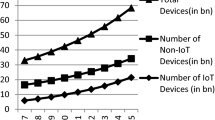Abstract
The need for connected devices is increasing rapidly in response to the expanding demand for internet connectivity and related services. Due to the high need for IoT applications, new methods and tools have been developed. RPL is a protocol suite used in IoT networks that facilitates communication and movement between nodes. Commercial implementation of the Internet of Thing (IoT) is hampered by a small number of security problems, despite the fact that there are many benefits to adopting IoT. The EVV approach is what the authors suggest utilizing in order to locate the rank node in an RPL topology that has been incorrectly assigned. A rank value is a numerical representation of each node's position in the tree in relation to the root node. To identify the malicious hub, the proposed EVV method is implemented at the root hub. Attackers in RPL use the energy meter to their advantage and launch a variety of attacks by moving up the RPL directed attack graph (DODAG). This work proposes an energy-based intrusion detection module to identify these attacks and the malicious nodes. Against a rank attack, also known as a rank inconsistency attack (RIA), this EVV module can hold its own. Select network parameters are used to evaluate the proposed EVV method against the current systems. Thus, compared to prior methods, the EVV significantly decreased the time required for both attacker identification and network convergence.




Similar content being viewed by others
Data Availability
Data sharing is not applicable to this article as no datasets were generated or analysed during the current study.
References
Al Sawafi Y, Touzene A, Day K, Alzeidi N. Toward hybrid RPL based IoT sensing for smart city. In: International conference on Information Networking (ICOIN), IEEE. 2018. p. 599–604.
Christian C, Poplade D, Nogueira M, Santos A (2015) Detection of sinkhole attacks for supporting secure routing on 6lowpan for internet of things. In: Integrated Network Management (IM), IFIP/IEEE international symposium on IEEE.
Jorge G, Monteiro E, Silva JS. Security for the internet of things: a survey of existing protocols and open research issues. IEEE Commun Surv Tutor. 2015;17(3):1294–312.
De La Cruz J (2017) Analysis of different routing Attacks against WSN’s using RPL with Contiki OS and Cooja Simulator. Dissertation.
Pallavi S, Sarangi SR. Internet of things: architectures, protocols, and applications. J Electr Comput Eng. 2017.
Kumar P, Baliyan A, Prasad KR, Sreekanth N, Jawarkar P, Roy V, Amoatey ET. Machine learning enabled techniques for protecting wireless sensor networks by estimating attack prevalence and device deployment strategy for 5G networks. Wirel Commun Mobile Comput. 2022;2022:5713092. https://doi.org/10.1155/2022/5713092.
Hussain F, Hussain R, Hassan SA, Hossain E. Machine learning in IoT security: current solutions and future challenges. IEEE Commun Surv Tutor. 2020;22:1686–721.
Al-Garadi MA, Mohamed A, Al-Ali AK, Du X, Ali I, Guizani M. A survey of machine and deep learning methods for IoT security. IEEE Commun Surv Tutor. 2018;22:1646–85.
Yahya F, Zaki AFA, Moung EG, Sallehudin H, Bakar NAA, Utomo RG. An IoT-based coastal recreational suitability system using effective messaging protocol. Int J Adv Comput Sci Appl. 2021;12:8.
Routray SK, Gopal D, Javali A, Sahoo A. Narrowband IoT (NBIoT) assisted smart grids. In: Proceedings of the 2021 international conference on Artificial Intelligence and Smart Systems (ICAIS), Coimbatore, India. 2021. p. 1454–8.
Sangra P, Rana B, Singh Y. Energy efficiency in IoT-based smart healthcare. In: Proceedings of third international conference on Computing, Communications, and Cyber-Security. Singapore: Springer: 2023. p. 503–15.
Mazhar T, Malik MA, Haq I, Rozeela I, Ullah I, Khan MA, Adhikari D, Ben Othman MT, Hamam H. The role of ML, AI and 5G technology in smart energy and smart building management. Electronics. 2022;11:3960.
Shukla PK, Sukla PK, Roy V. Network physical address based encryption technique using digital logic. Int J Sci Technol Res. 2020;9(4):3119–22.
Janarthanan T, Zargari S. Feature selection in UNSW-NB15 and KDDCUP’99 datasets. In: Proceedings of the 2017 IEEE 26th international symposium on Industrial Electronics (ISIE), Edinburgh, UK. 2017. p. 1881–6.
Karn RR, Kudva P, Elfadel IM. Learning without forgetting: a new framework for network cyber security threat detection. IEEE Access. 2021;9:137042–62.
Ahmed M, Byreddy S, Nutakki A, Sikos LF, Haskell-Dowland P. ECU-IoHT: a dataset for analyzing cyberattacks in internet of health things. Ad Hoc Netw. 2021;122: 102621.
Moustafa N. A new distributed architecture for evaluating AI-based security systems at the edge: network TON_IoT datasets. Sustain Cities Soc. 2021;72: 102994.
Kilincer IF, Ertam F, Sengur A. Machine learning methods for cyber security intrusion detection: datasets and comparative study. Comput Netw. 2021;188:107840.
Roy V. An improved image encryption consuming fusion transmutation and edge operator. J Cybersecur Inf Manag. 2021;8(1):42–52.
Neshenko N, Bou-Harb E, Crichigno J, Kaddoum G, Ghani N. Demystifying IoT security: an exhaustive survey on IoT vulnerabilities and a first empirical look on Internet-scale IoT exploitations. IEEE Commun Surv Tutor. 2019;21:2702–33.
Narayanan U, Paul V, Joseph S. Decentralized blockchain based authentication for secure data sharing in Cloud-IoT, DeBlock-Sec. J Ambient Intell Humaniz Comput. 2021;13:769–87.
Kalyani G, Chaudhari S. Cross layer security MAC aware routing protocol for IoT networks. Wirel Pers Commun. 2022;123:935–57.
Ali F, Mathew S. “An efficient multilevel security architecture for blockchain-based IoT networks using principles of cellular automata. Peer J Comput Science. 2022;8: e989.
Kaňuch P, Macko D. E-HIP: an energy-efficient open HIP-based security in IoT networks. Sensors. 2019;19:4921.
Author information
Authors and Affiliations
Corresponding author
Ethics declarations
Conflict of Interest
First author and second author declare that they have no conflict of interest.
Ethical Approval
This article does not contain any studies with animals performed by any of the authors.
Additional information
Publisher's Note
Springer Nature remains neutral with regard to jurisdictional claims in published maps and institutional affiliations.
This article is part of the topical collection “Machine Intelligence and Smart Systems” guest edited by Manish Gupta and Shikha Agrawal.
Rights and permissions
Springer Nature or its licensor (e.g. a society or other partner) holds exclusive rights to this article under a publishing agreement with the author(s) or other rightsholder(s); author self-archiving of the accepted manuscript version of this article is solely governed by the terms of such publishing agreement and applicable law.
About this article
Cite this article
Ramu, K., Gomathi, N., Suman, S.K. et al. Unveiling the Energy-Based Validation and Verification (EVV) Method for Perceiving and Averting Rank Inconsistency Attacks (RIA) for Guarding IoT Routing. SN COMPUT. SCI. 5, 249 (2024). https://doi.org/10.1007/s42979-023-02568-5
Received:
Accepted:
Published:
DOI: https://doi.org/10.1007/s42979-023-02568-5




